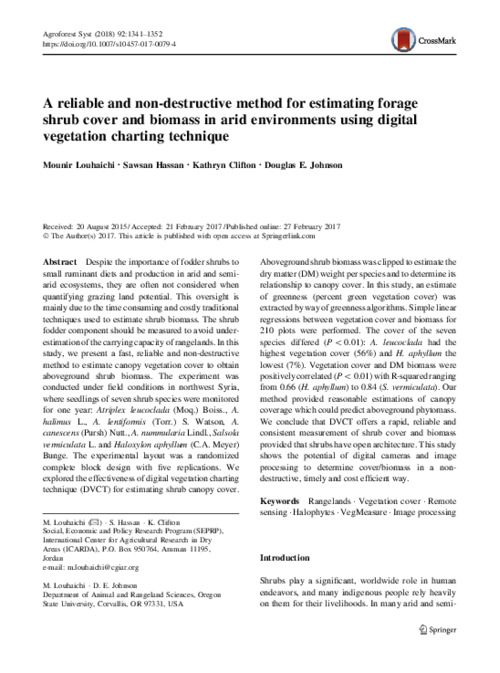A reliable and non-destructive method for estimating forage shrub cover and biomass in arid environments using digital vegetation charting technique
Abstract
Despite the importance of fodder shrubs to small ruminant diets and production in arid and semiarid ecosystems, they are often not considered when quantifying grazing land potential. This oversight is mainly due to the time consuming and costly traditional techniques used to estimate shrub biomass. The shrub fodder component should be measured to avoid underestimation of the carrying capacity of rangelands. In this study, we present a fast, reliable and non-destructive method to estimate canopy vegetation cover to obtain aboveground shrub biomass. The experiment was conducted under field conditions in northwest Syria, where seedlings of seven shrub species were monitored for one year: Atriplex leucoclada (Moq.) Boiss., A. halimus L., A. lentiformis (Torr.) S. Watson, A. canescens (Pursh) Nutt., A. nummularia Lindl., Salsola vermiculata L. and Haloxylon aphyllum (C.A. Meyer) Bunge. The experimental layout was a randomized complete block design with five replications. We explored the effectiveness of digital vegetation charting technique (DVCT) for estimating shrub canopy cover. Aboveground shrub biomasswas clipped to estimate the dry matter (DM) weight per species and to determine its relationship to canopy cover. In this study, an estimate of greenness (percent green vegetation cover) was extracted by way of greenness algorithms. Simple linear regressions between vegetation cover and biomass for 210 plots were performed. The cover of the seven species differed (P\0.01): A. leucoclada had the highest vegetation cover (56%) and H. aphyllum the lowest (7%). Vegetation cover and DM biomass were positively correlated (P\0.01) with R-squared ranging from 0.66 (H. aphyllum) to 0.84 (S. vermiculata). Our method provided reasonable estimations of canopy coverage which could predict aboveground phytomass. We conclude that DVCT offers a rapid, reliable and consistent measurement of shrub cover and biomass provided that shrubs have open architecture. This study shows the potential of digital cameras and image processing to determine cover/biomass in a nondestructive, timely and cost efficient way

